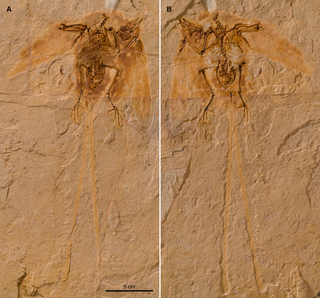
The Enantiornithes, also known as enantiornithines or enantiornitheans in literature, are a group of extinct avialans, the most abundant and diverse group known from the Mesozoic era. Almost all retained teeth and clawed fingers on each wing, but otherwise looked much like modern birds externally. Over eighty species of Enantiornithes have been named, but some names represent only single bones, so it is likely that not all are valid. The Enantiornithes became extinct at the Cretaceous–Paleogene boundary, along with Hesperornithes and all other non-avian dinosaurs.

Scansoriopterygidae is an extinct family of climbing and gliding maniraptoran dinosaurs. Scansoriopterygids are known from five well-preserved fossils, representing four species, unearthed in the Tiaojishan Formation fossil beds of Liaoning and Hebei, China.

Jeholornis is a genus of avialan dinosaurs that lived between approximately 122 and 120 million years ago during the early Cretaceous Period in China. Fossil Jeholornis were first discovered in the Jiufotang Formation in Hebei Province, China and additional specimens have been found in the older Yixian Formation.

Yandangornis is a genus of theropods from the Late Cretaceous Tangshang Formation of China. It lived 81.5 million years ago in what is now China. The type species, Y. longicaudus, was formally described by Cai and Zhou in 1999.

Avialae is a clade containing the only living dinosaurs, the birds, and their ancestors. It is usually defined as all theropod dinosaurs more closely related to birds (Aves) than to deinonychosaurs, though alternative definitions are occasionally used.

Confuciusornithidae is an extinct family of pygostylian avialans known from the Early Cretaceous, found in northern China. They are commonly placed as a sister group to Ornithothoraces, a group that contains all extant birds along with their closest extinct relatives. Confuciusornithidae contains four genera, possessing both shafted and non-shafted (downy) feathers. They are also noted for their distinctive pair of ribbon-like tail feathers of disputed function.

Ornithothoraces is a group of avialan dinosaurs that includes all enantiornithes and the euornithes, which includes modern birds and their closest ancestors. The name Ornithothoraces means "bird thoraxes". This refers to the modern, highly advanced anatomy of the thorax that gave the ornithothoracines superior flight capability compared with more primitive avialans. This anatomy includes a large, keeled breastbone, elongated coracoids and a modified glenoid joint in the shoulder, and a semi-rigid rib cage. In spite of this at least the sternum seems to have developed convergently rather than being a true homology.

Pygostylia is a group of avialans which includes the Confuciusornithidae and all of the more advanced species, the Ornithothoraces.
Zhongornis is a genus of primitive maniraptoran dinosaurs that lived during the Early Cretaceous. It was found in rocks of the Yixian Formation in Lingyuan City (China), and described by Gao et al. in 2008.

Longipterygidae is a family of early enantiornithean avialans from the Early Cretaceous epoch of China. All known specimens come from the Jiufotang Formation and Yixian Formation, dating to the early Aptian age, 125-120 million years ago.

Xiaotingia is a genus of anchiornithid theropod dinosaur from Middle Jurassic or early Late Jurassic deposits of western Liaoning, China, containing a single species, Xiaotingia zhengi.

Euornithes is a natural group which includes the most recent common ancestor of all avialans closer to modern birds than to Sinornis.

Anchiornithidae is a family of small paravian dinosaurs. Anchiornithids have been classified at varying positions in the paravian tree, with some scientists classifying them as a distinct family, a basal subfamily of Troodontidae, members of Archaeopterygidae, or an assemblage of dinosaurs that are an evolutionary grade within Avialae or Paraves.
Yangavis is a basal pygostylian genus, belonging to the Confuciusornithidae, that in the Early Cretaceous lived in the area of present China. The type species is Yangavis confucii.

Jinguofortis is a genus of primitive avialan belonging to the clade Pygostylia that lived during the Valanginian stage of the Early Cretaceous. It was found in the Dabeigou Formation in northeastern China, and isotope dating from the samples overlying the bird-bearing horizon is 127 million years ago.

Jinguofortisidae is an extinct family of early pygostylian dinosaurs known from the Early Cretaceous, found in northern China.

Fukuipteryx is an extinct genus of basal avialan dinosaurs found in Early Cretaceous deposits from Japan's Kitadani Formation. It contains one species, Fukuipteryx prima.

Cratonavis is an extinct genus of pygostylian avialian from the Early Cretaceous Jiufotang Formation of Liaoning Province, China. The genus contains a single species, C. zhui, known from a complete skeleton.
Imparavis is an extinct genus of enantiornithine birds from the Early Cretaceous (Aptian-aged) Jiufotang Formation of Liaoning Province, China. The genus contains a single species, I. attenboroughi, known from a well-preserved skeleton.
























